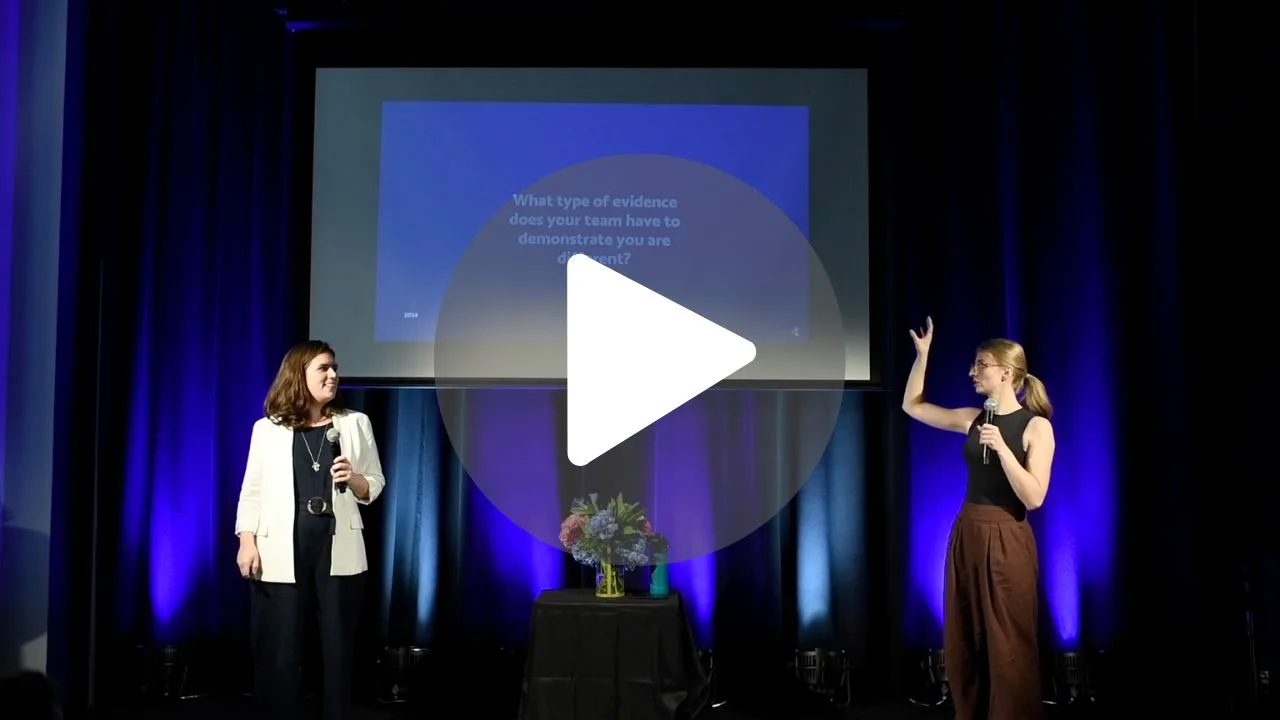How to Build a Differentiated Product Messaging Strategy That Works
with Marta Vucci and Kelsey Hall


Messaging is a fraught topic for marketing teams. Many of us are handed down jargon-y copy from product or brand teams, asked to launch campaigns and initiatives at the whim of leadership, or find ourselves stuck in the seemingly endless loop of finding verbiage that is just right and pleases everybody. Meanwhile, some of us are searching for helpful product or service messaging tips online and wind up frustrated by vague, abstract advice about how to tell your audience “why they should choose you”…duh!
If this feels familiar — you’re not alone, and you’re in the right place.
Marketing teams should be at the center of message development and identifying clear differentiators. As marketers, we should feel empowered to lead constructive conversations about our company’s strengths and weaknesses, customer feedback, and competitor messaging, all of which are at the heart of developing truly great marketing materials.
How do I actually start a conversation about differentiators at my company? We’re breaking it down by:
1. Define Your Key Differentiators
Differentiators are the aspects of your product, service, or brand that set you apart from the competition in a meaningful way. They can range from unique features and innovative benefits to exceptional customer experiences.
The goal is to find the crossover between where there are gaps in the market, and how you best service your users. Collecting first hand data and insights will help you understand what your most valuable differentiators are.
Conduct Competitive Analysis
Start with a thorough competitive analysis to understand the market. This involves researching your competitors to understand their offerings, strengths, and weaknesses. By doing so, you can identify gaps in the market or areas where your product can offer something distinctly better or different. This step is foundational, as it provides the context needed for effective differentiation.
Also be sure to research how users find your competitors. What messaging do they prioritize across their marketing channels? Does one competitor always appear when users search for a specific feature (cheapest, fastest, customizable, etc)? This will identify existing correlations audiences have with your competitors, which will then help you prioritize where there are gaps that you can compete in.

Engage with Your Audience
Feedback gathered directly from your existing customer base is invaluable. Engage with your audience through surveys and interviews, and review any sales logs you have available.
- How are your customers using your product?
- What do they value most about your product?
- When would they be most inclined to bring your product up with others?
Hearing directly from your audience may stir up surprising or unexpected insights that your internal teams may not identify.
Evaluate Internal Strengths
Leverage existing internal resources to identify potential differentiators. This could include — to name just a few — interviews with internal product experts and client success teams, proprietary technology or processes, and first party research data. Internal strengths can uncover unique ways your product provides value that are difficult for competitors to replicate.
Identifying differentiators enables three key functions of your overall marketing strategy: Standing Out, Consistency, and Expertise, all of which are crucial to running eye-catching campaigns and building an authentic organic presence with your audience.
2. Craft Your Message
Once you’ve identified your differentiators, you must determine how to communicate them in a way that will connect with your target customers. This is how you build trust and create lasting loyalty.
Articulating Differentiators
We have 3 main tips to keep in mind so you can articulate your differentiators in a way that resonates with audiences:
Speak Your Audiences’ Language
- Use language and tone that feels comfortable and familiar to your audience. Incorporating industry jargon to make yourself sound like an expert is not useful if it is not how your audience speaks in their day-to-day.
- Speak directly to your audience’s pain points and desires. Instead of telling them what you do, tell them how you will help solve their problems or reach their goals.
Be Specific & Concrete
- Highlight specific benefits, and avoid vague statements.
- Use data as evidence to support your differentiators. Pulling in statistics and tangible results validates your claims and creates trust.
Keep it Simple
- Focus on 1 (maybeee 2) key differentiators at a time. You do not need to say everything at once, be specific and targeted with the message you are sending.
- Do not overcomplicate your messaging. Be direct. Use clear and concise language that cannot be misinterpreted.

Utilize Storytelling
Human beings are storytellers, this is how we best relay and intake information! Communicating your differentiators through stories will make them more memorable and will allow your audience to personally relate.
Building a strong narrative around your product could look like testimonials and narrative case studies that showcase the pain your customers felt before working with you, and how your product has improved their daily lives.
Making an effort to communicate in a humanized way will create an emotional association that allows you to quickly build deeper connections with your audience.
3. Action Your Messaging in Your Marketing Efforts
At this point, you have done research to identify your key differentiators, and you have crafted your messaging to best convey those differentiators to your target audience. The last step is putting all of this work into action across your marketing efforts, where you will be able to test and measure real results! Let’s discuss what that should look like.
Maintain Consistency Throughout the Funnel
Moving down the funnel should feel seamless for users, which can be achieved through creating consistent messaging across each phase of the funnel.
Here is an outline of how you can highlight your differentiators consistently throughout the funnel:
Top of funnel– Reach your audience by addressing the unique pain points that your product solves for. This should capture their attention and trigger intrigue.
Middle of funnel– Show users how you stack up against the competition. Employ compelling case studies, side by side competitor analysis, and customer testimonials.
Bottom of funnel– Instead of telling your audience solely what you can do, focus on the impact they will feel and the outcomes they will be able to achieve when using your product.
Push a Cohesive Story Across Channels
Whether they are interacting with an educational piece of content on your website, an ad on social media, or an introductory email sequence, people should be hearing a consistent story whenever they are engaging with your brand. Reiterating the same story across all of your marketing channels will make it more memorable and help you solidify your stance in the market.
Of course, you will want to be sure to tailor your tone and the formatting to best fit each unique platform you utilize, however the messaging around your product’s key differentiators should remain consistent.
Track Performance & Test
If you are not tracking the performance of your marketing campaigns, it will be near impossible to validate your product or service messaging. Ensuring your campaigns are properly tagged and tracking across all channels will help you understand the effectiveness of your messaging strategy.
Proper tracking will also allow you to test and optimize your messaging strategy over time. Do certain audiences react more strongly to seeing a particular pain point or differentiator? Is there messaging that encourages users to engage or take a particular action more frequently? Your messaging strategy should constantly be evolving as you collect data, find new audiences to target, and better understand your positioning in the market.
Regardless of where your team is in your messaging journey, identifying, articulating, and creating actions towards clear messaging around your key differentiators is a non-negotiable for marketing. This is especially true if you want to cut through the clutter of marketing materials your audience interacts with every day.
By having a strong understanding of your audiences’ needs and how you can service them in a way none of your competitors can, you are able to create effective marketing messaging that will create long-lasting associations and loyalty with your audience.
And don’t forget — Differentiators are not just about being different. It is about how you provide unique value that is highly meaningful to your audiences, and meets their needs where they are at.
Talk to an expert about your marketing needs







